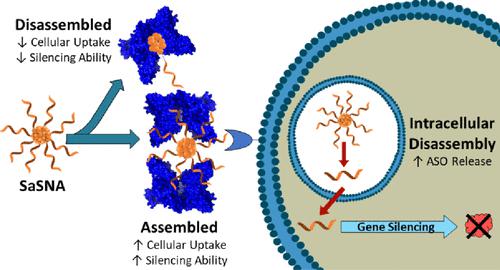Our official English website, www.x-mol.net, welcomes your
feedback! (Note: you will need to create a separate account there.)
Control of the Assembly and Disassembly of Spherical Nucleic Acids Is Critical for Enhanced Gene Silencing
ACS Nano ( IF 15.8 ) Pub Date : 2024-01-24 , DOI: 10.1021/acsnano.3c05940
Jathavan Asohan 1 , Hassan H Fakih 1 , Trishalina Das 1 , Hanadi F Sleiman 1
ACS Nano ( IF 15.8 ) Pub Date : 2024-01-24 , DOI: 10.1021/acsnano.3c05940
Jathavan Asohan 1 , Hassan H Fakih 1 , Trishalina Das 1 , Hanadi F Sleiman 1
Affiliation

|
Spherical nucleic acids─nanospheres with nucleic acids on their corona─have emerged as a promising class of nanocarriers, aiming to address the shortcomings of traditional nucleic therapeutics, namely, their poor stability, biodistribution, and cellular entry. By conjugating hydrophobic monomers to a growing nucleic acid strand in a sequence-defined manner, our group has developed self-assembled spherical nucleic acids (SaSNAs), for unaided, enhanced gene silencing. By virtue of their self-assembled nature, SaSNAs can disassemble under certain conditions in contrast to covalent or gold nanoparticle SNAs. Gene silencing involves multiple steps including cellular uptake, endosomal escape, and therapeutic cargo release. Whether assembly vs disassembly is advantageous to any of these steps has not been previously studied. In this work, we modify the DNA and hydrophobic portions of SaSNAs and examine their effects on stability, cellular uptake, and gene silencing. When the linkages between the hydrophobic units are changed from phosphate to phosphorothioate, we find that the SaSNAs disassemble better in endosomal conditions and exhibit more efficacious silencing, despite having cellular uptake similar to that of their phosphate counterparts. Thus, disassembly in the endolysosomal compartments is advantageous, facilitating the release of the nucleic acid cargo and the interactions between the hydrophobic units and endosomal lipids. We also find that SaSNAs partially disassemble in serum to bind albumin; the disassembled, albumin-bound strands are less efficient at cellular uptake and gene silencing than their assembled counterparts, which can engage scavenger receptors for internalization. When the DNA portion is cross-linked by G-quadruplex formation, disassembly decreases and cellular uptake significantly increases. However, this does not translate to greater gene silencing, again illustrating the need for disassembly of the SaSNAs when they are in the endosome. This work showcases the advantages of the dual nature of SaSNAs for gene silencing, requiring extracellular assembly and disassembly inside the cell compartments.
中文翻译:

控制球形核酸的组装和分解对于增强基因沉默至关重要
球形核酸(冠状上带有核酸的纳米球)已成为一类有前途的纳米载体,旨在解决传统核酸疗法的缺点,即稳定性差、生物分布和细胞进入性差。通过以序列定义的方式将疏水单体与不断生长的核酸链缀合,我们的团队开发了自组装球形核酸(SaSNA),用于无需辅助的增强基因沉默。与共价或金纳米粒子 SNA 相比,SaSNA 凭借其自组装性质,可以在某些条件下分解。基因沉默涉及多个步骤,包括细胞摄取、内体逃逸和治疗性物质释放。先前尚未研究过组装与拆卸是否对这些步骤中的任何一个有利。在这项工作中,我们修改了 SaSNA 的 DNA 和疏水部分,并检查了它们对稳定性、细胞摄取和基因沉默的影响。当疏水单元之间的连接从磷酸盐变为硫代磷酸盐时,我们发现 SaSNA 在内体条件下分解得更好,并且表现出更有效的沉默,尽管细胞摄取与磷酸盐对应物相似。因此,在内溶酶体区室中的分解是有利的,促进核酸货物的释放以及疏水单元和内体脂质之间的相互作用。我们还发现 SaSNA 在血清中部分分解以结合白蛋白;拆卸后的白蛋白结合链在细胞摄取和基因沉默方面的效率低于其组装的对应链,后者可以与清道夫受体进行内化。 当 DNA 部分通过 G-四链体形成交联时,分解减少,细胞摄取显着增加。然而,这并不意味着更大的基因沉默,再次说明当 SaSNA 在内体中时需要对其进行分解。这项工作展示了 SaSNA 对于基因沉默的双重性质的优势,需要细胞外组装和细胞室内拆卸。
更新日期:2024-01-24
中文翻译:

控制球形核酸的组装和分解对于增强基因沉默至关重要
球形核酸(冠状上带有核酸的纳米球)已成为一类有前途的纳米载体,旨在解决传统核酸疗法的缺点,即稳定性差、生物分布和细胞进入性差。通过以序列定义的方式将疏水单体与不断生长的核酸链缀合,我们的团队开发了自组装球形核酸(SaSNA),用于无需辅助的增强基因沉默。与共价或金纳米粒子 SNA 相比,SaSNA 凭借其自组装性质,可以在某些条件下分解。基因沉默涉及多个步骤,包括细胞摄取、内体逃逸和治疗性物质释放。先前尚未研究过组装与拆卸是否对这些步骤中的任何一个有利。在这项工作中,我们修改了 SaSNA 的 DNA 和疏水部分,并检查了它们对稳定性、细胞摄取和基因沉默的影响。当疏水单元之间的连接从磷酸盐变为硫代磷酸盐时,我们发现 SaSNA 在内体条件下分解得更好,并且表现出更有效的沉默,尽管细胞摄取与磷酸盐对应物相似。因此,在内溶酶体区室中的分解是有利的,促进核酸货物的释放以及疏水单元和内体脂质之间的相互作用。我们还发现 SaSNA 在血清中部分分解以结合白蛋白;拆卸后的白蛋白结合链在细胞摄取和基因沉默方面的效率低于其组装的对应链,后者可以与清道夫受体进行内化。 当 DNA 部分通过 G-四链体形成交联时,分解减少,细胞摄取显着增加。然而,这并不意味着更大的基因沉默,再次说明当 SaSNA 在内体中时需要对其进行分解。这项工作展示了 SaSNA 对于基因沉默的双重性质的优势,需要细胞外组装和细胞室内拆卸。

































 京公网安备 11010802027423号
京公网安备 11010802027423号